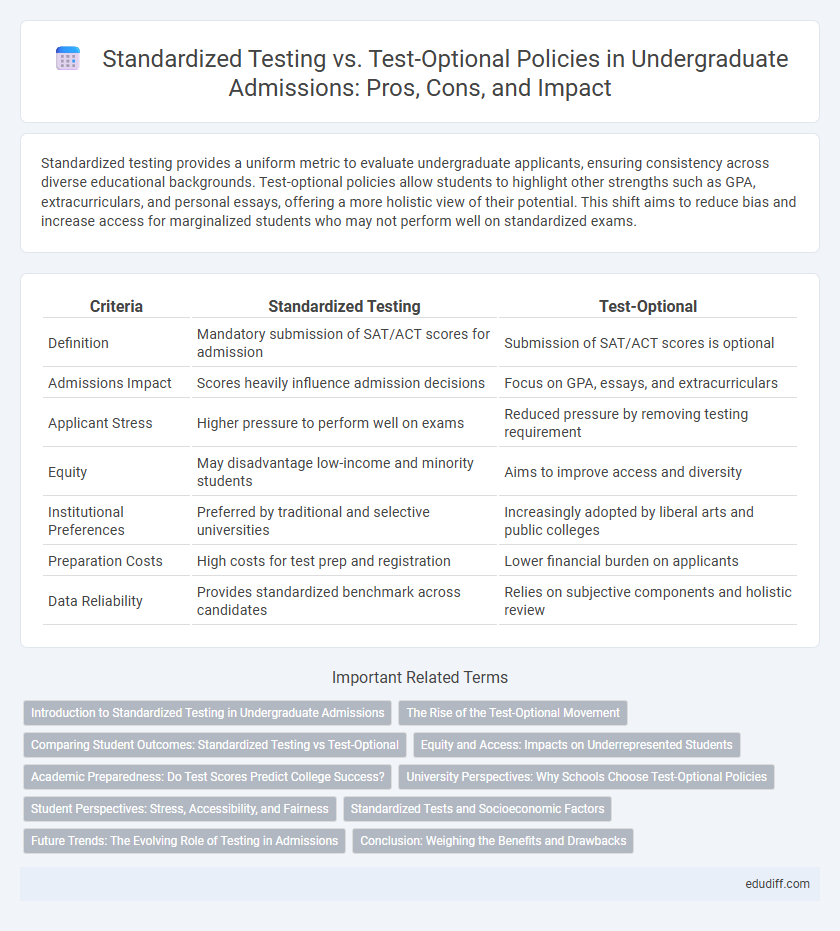Standardized testing provides a uniform metric to evaluate undergraduate applicants, ensuring consistency across diverse educational backgrounds. Test-optional policies allow students to highlight other strengths such as GPA, extracurriculars, and personal essays, offering a more holistic view of their potential. This shift aims to reduce bias and increase access for marginalized students who may not perform well on standardized exams.
Table of Comparison
| Criteria | Standardized Testing | Test-Optional |
|---|---|---|
| Definition | Mandatory submission of SAT/ACT scores for admission | Submission of SAT/ACT scores is optional |
| Admissions Impact | Scores heavily influence admission decisions | Focus on GPA, essays, and extracurriculars |
| Applicant Stress | Higher pressure to perform well on exams | Reduced pressure by removing testing requirement |
| Equity | May disadvantage low-income and minority students | Aims to improve access and diversity |
| Institutional Preferences | Preferred by traditional and selective universities | Increasingly adopted by liberal arts and public colleges |
| Preparation Costs | High costs for test prep and registration | Lower financial burden on applicants |
| Data Reliability | Provides standardized benchmark across candidates | Relies on subjective components and holistic review |
Introduction to Standardized Testing in Undergraduate Admissions
Standardized testing plays a critical role in undergraduate admissions by providing a uniform metric to assess applicants' academic abilities across diverse educational backgrounds. Tests like the SAT and ACT evaluate skills in math, reading, and writing, offering colleges a comparative framework to predict student success. Despite its widespread use, the debate between standardized testing and test-optional policies centers on balancing equitable access with comprehensive applicant evaluation.
The Rise of the Test-Optional Movement
The rise of the test-optional movement has reshaped undergraduate admissions by reducing the emphasis on standardized tests such as the SAT and ACT. Research shows that test-optional policies increase diversity and access for underrepresented students without compromising academic performance or graduation rates. Universities adopting these policies leverage holistic review processes that consider GPA, extracurricular activities, and personal essays more heavily.
Comparing Student Outcomes: Standardized Testing vs Test-Optional
Research indicates that students admitted through test-optional policies often demonstrate comparable or higher college GPA and retention rates than those admitted with standardized test scores. Standardized testing provides a uniform metric but may not fully capture a student's potential, especially for underrepresented groups. Test-optional approaches promote diversity and access while maintaining academic success indicators.
Equity and Access: Impacts on Underrepresented Students
Standardized testing often disadvantages underrepresented students by reflecting socioeconomic disparities and limiting access to test preparation resources, thereby reducing college admission opportunities. Test-optional policies promote equity by allowing applicants to showcase strengths beyond test scores, emphasizing holistic reviews that consider diverse backgrounds and experiences. Research indicates that test-optional admissions increase diversity and improve access for students from marginalized communities, fostering a more inclusive academic environment.
Academic Preparedness: Do Test Scores Predict College Success?
Standardized test scores like the SAT and ACT have traditionally been used as indicators of academic preparedness, correlating with first-year GPA and retention rates in many studies. However, test-optional policies prioritize high school GPA, coursework rigor, and extracurricular achievements, which research shows can be equally or more predictive of long-term college success. Institutions adopting test-optional admissions report diverse and capable student bodies, suggesting that test scores alone are not definitive predictors of academic performance.
University Perspectives: Why Schools Choose Test-Optional Policies
Universities adopting test-optional policies aim to promote diversity and access by reducing barriers for underrepresented and economically disadvantaged students. Research indicates that high school GPA, extracurricular involvement, and personal statements often predict college success more effectively than standardized test scores. Test-optional approaches also help institutions attract a broader applicant pool, reflecting a commitment to holistic admissions practices.
Student Perspectives: Stress, Accessibility, and Fairness
Standardized testing often elevates student stress levels due to high-stakes pressure and rigid time constraints, while test-optional policies alleviate anxiety by allowing students to showcase diverse strengths beyond exam scores. Accessibility improves under test-optional systems as students from varied socioeconomic backgrounds face fewer barriers linked to costly test preparation and limited testing sites. Fairness perceptions shift since test-optional approaches can reduce biases inherent in standardized exams, promoting a more holistic evaluation of academic potential and personal achievements.
Standardized Tests and Socioeconomic Factors
Standardized tests such as the SAT and ACT often reflect socioeconomic disparities, with students from higher-income families scoring significantly higher due to access to test prep resources and educational support. Research shows that standardized testing can disproportionately disadvantage low-income and minority students, reinforcing existing educational inequalities. Colleges considering socioeconomic factors increasingly debate the fairness and predictive validity of these exams in undergraduate admissions.
Future Trends: The Evolving Role of Testing in Admissions
Future trends in undergraduate admissions indicate a gradual shift toward test-optional policies as colleges prioritize holistic review processes. Data reveals that institutions adopting test-optional approaches report increased diversity and equitable access among applicants. Emerging technologies and alternative assessment methods are expected to further transform standardized testing's role in evaluating student potential.
Conclusion: Weighing the Benefits and Drawbacks
Standardized testing offers a consistent metric for evaluating academic readiness but may disadvantage students from diverse backgrounds or with test anxiety. Test-optional policies promote a holistic review, allowing for a broader assessment of a student's abilities and achievements beyond exam scores. Balancing these approaches requires assessing institutional goals, diversity commitments, and fairness in admissions to optimize student success and equity.
Standardized Testing vs Test-Optional Infographic

 edudiff.com
edudiff.com